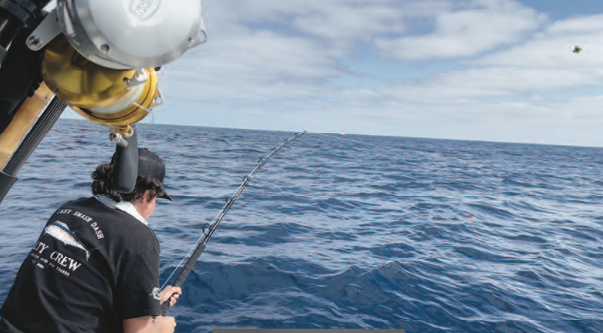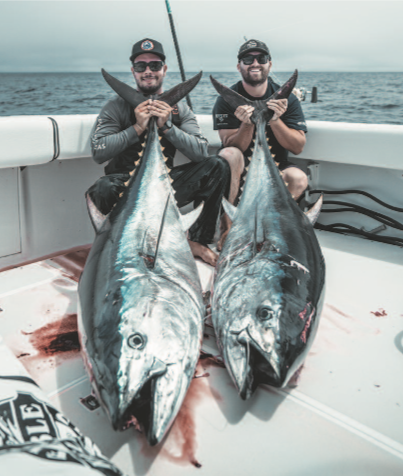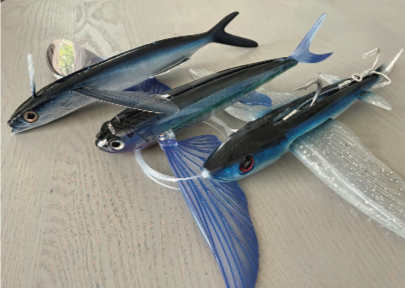
BY JEFF NEUBAUER
With the tremendous bluefin bite happening right now, let’s take a close look at one of the most exhilarating ways of targeting them — using flying fish baits under a kite.
Fishing big bluefin with flying fish lures is very similar to fishing for them using more traditional dead baits or the Original Yum- mee Flyer — the gear for the kite and lure rod is the same identical setup as you would typically use with dead baits. So, first, let’s look at the gear involved.
Kite rods and reels
Controlling the kite can be done with a larger capacity levelwind reel with roughly 700 yards of 50-pound line. It doesn’t have to be fancy reel, but it needs to have sufficient drag so you can reel a kite back in high wind conditions without the drag slipping.
If you have the luxury, a high-capacity electric reel like the Daiwa Tanacom 1000 at your fingertips is a nice addition to have to speed up the process. I prefer a standard 8-foot rod for easier de- employments and preventing accidental damage when traveling from school to school.
Kite choices
The two main styles of kites are a square fabric kite like a Bob Lewis assisted with a 36-inch helium balloon, or the larger winged Boston Big Game kite. The helium balloon assist will keep the kite flying at a more consistent altitude, which helps keep the lure on the water more consistently. The Boston Big Game kite requires a minimum 8 knots of wind and no helium, but gusts can make it tricky to handle.
Lure rods

For using the kite or drifting lures it’s important to get the lure far away from the boat because of the skittish behavior of bluefin. For these reasons you will need serious line capacity (1,000 yards or more). Personally, I really like the Penn International 50W VISX. It’s a heavy-duty open-frame reel and can put down some serious drag when grinding it out on the rail. Use nothing less than 130-pound braid or be prepared for casualties.
If you want to opt for heavier line on the reel, it will also work but typically varieties of that size are hollow-core and will grab the wind and slack more due to in- creased surface area. When it comes to rod selection, it needs to have a solid backbone but be parabolic enough to steady pressure of the headshakes of big fish. The 3X heavy outfits like Phenix Rods HAX720X3H, which is rated for 60- to 130-pound, seems to be the right fit for the majority of the fish here in California.
Lure selection
When it comes to flying fish lures, there has become quite the variety available now. The Original Yummee Fly’N Fish was designed for use on the East Coast, originating back to 1992 when it was first was developed by Carolina Lures. Although it was adopted for use in California un- der the kite when the larger fish reappeared in 2015, it didn’t accurately represent our local flying fish species.
The California Flyer quickly became a popular choice for anglers because of its size (matching the local bait size) and the ability to fish it actively on the troll at 8 knots or on a drift as a replacement of using an actual dead bait. It’s proven to be a great and deadly lure over the last few years.

The Frequent Flyer from Mag Bay Lures also came to market with a different approach. The lure was the first floating flying fish lure that allowed anglers to drift it without the use of the kite. This allowed passengers on sport boats to have the ability to still fish a flying fish lure without having to bring a kite or frozen baits aboard and fish multiple baits at the same time.
The last and most recent lure to make it to the market is the Nomad Designs’ Slipstream. Its de- sign comes in multiple sizes and colors to match the variety of species found around the world. It is also a floating design that can be rigged several different ways for trolling and kite use.
Stabilized binoculars
We are specifically looking for fish active on the surface, which is why a pair of stabilized binoculars is a must when it comes to spotting fish and sometimes monitoring your lure on a kite. The more affordable stabilized Fujinon TSX1440 work just fine, but the top-of-the-line Fraser Optics S250 are nearly double the price. Typically, in excellent sea conditions you can spot something on the surface almost a mile away with a naked eye. With a pair of stabilized binoculars and a little elevation, that changes to almost 7 miles. The amount of water you can monitor (and thus fish, birds and bait you can spot) changes significantly!
Rigging bluefin baits
When it comes to rigging a flying fish lure, it’s going to be a little more specific to the lure itself so follow the manufactures recommendations. Generally speaking, it’s going to consist of a larger J hook rigged on the top of the lure with a 9/0 to 12/0 J hook, followed by a trailing treble hook in the 6/0 to 7/0 size acting as a stinger. Do not use zip ties to hold the hooks in place — you want the hooks to break free when the fish bites to separate the lure from the hook. If you are fishing the lure from a kite, 400-pound monofilament is the preferred leader size to help reduce abrasion. The leader will be out of the water so its size won’t be relevant to a fish’s reaction.
If you are fishing a lure without a kite, the leader is going to be visible so you should switch to fluorocarbon. A long leader — 10- to 20-feet preferably without any hardware (swivels, snap swivels, split rings, etc.) is going to work best. Any additional weight is going to make it sink, putting slack in your line and the incorrect presentation. In this situation, I prefer 130-pound size leader but nothing less than 100.

Strategy and teamwork
Be prepared and be organized! Bluefin can be the most hated fish in the ocean when they don’t co-operate, which is most of the time. But every once in a while, Mother Nature opens the door to excitement, and they act like a completely different animal, so you have to be ready.
The bite really depends on the school’s reaction — some won’t even look at a lure while others feast like hungry hippos, attacking everything. To fish them properly and maximize catches, working with a team of 4 or 5 people can really put the numbers on the boat. To start, you need a captain who is going to drive the boat, monitor the up and down meter and watch the lures presented on the kite with the binoculars. Two guys will be working the kite (one on the kite rod, and the other on the lure rod) and the spare guy can deploy floating lures, gaff fish, prep other lures and bleed/ice fish. It sounds like a lot but in the heat of the moment all these roles are very significant.
Have your lures rigged and ready; when deploying a lure on the kite, the initial send out at 2- 3 mph is all the action it needs or shifting the boat in and out of gear once deployed. Once bit, the quicker you get the kite in and the next lure setup out the quick- er the next bite happens, which is why you need to capitalize when you are on the school. Since you are using lures, there is no baits to defrost, skewers or wings to rig, it should be straight attach and go! When the bite stops and the meter shows no more action, drive upwind. You want to drive pass the school so they are no longer on the meter as your kite deployment will always be be- hind you anyways. If they are still on the surface, it will be much easier to locate them
Floating lures are the wild card when it comes to kite fishing. The old saying “more baits, more bites” still rings true. They are best deployed from the bow of the boat on so they can drift out of the shadow of the boat’s current and upwind. You want to get them away from the boat just as far as a kite lure but it’s going to
take some more time, which is also why they work well for slow- er bites when the fish are more scattered. Once they are in position, just put the rod in the holder with the clicker on in the strike position. There is no need to put an indicator on them you will lose sight of them after the first 30 yards of deployment anyways.
When the plan all comes together, you will end up with some great action and some seri- ous meat on the deck.
Watching these beasts eat on the surface is one of the most exciting ways to fish for them.
SoCal-based Jeff Neubauer runs the Chasing Pelagics YouTube channel (www.youtube.com/Chas- ing Pelagics) and website / online store www.chasingpelagics.com


